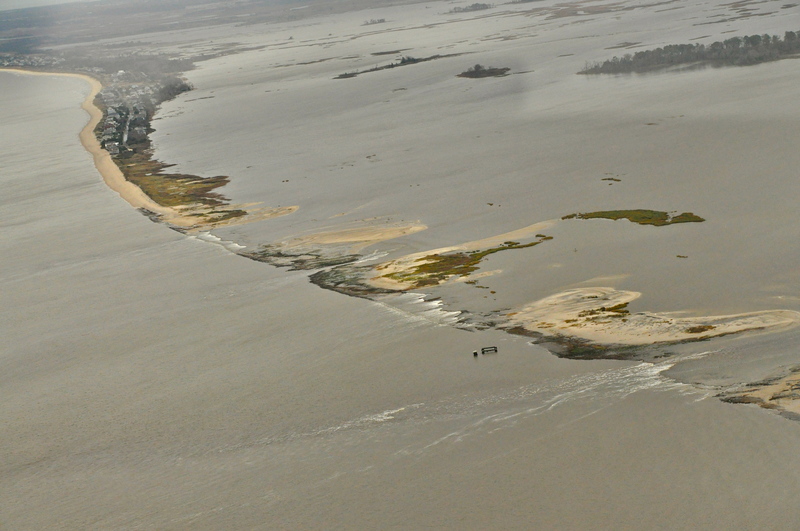Complex, state-of-the-art models have taken most of the guess work out of a $38 million project to repair breaches and restore thousands of acres of marshland at Prime Hook National Wildlife Refuge.
State-of-the-art science has become the foundation of a project to rebuild destroyed marshes and restore almost a mile of beach front along the Delaware Bay in the refuge.
For the first time, bathymetry, topography, salinity, water levels, water flow and tides have been used to develop hydrodynamic modeling using various scenarios in the refuge. The models are explained in depth in a 102-page report compiled by environmental consultant Atkins Global.
|
|
Input from some of the region's most experienced biologists, hydrologists and engineers has been used to develop the restoration plan. Scientists from the University of Delaware and Delaware State College will monitor each phase of the project.
The initial work to collect data and start development of the project has cost the U.S. Fish & Wildlife Service $250,000.
The Prime Hook refuge restoration will be one of the largest marsh/beach restoration projects ever attempted, said Al Rizzo, project leader for the Coastal Delaware National Wildlife Refuge Complex, which also includes Bombay Hook refuge. Work to fill the breaches could begin as early as this fall with marsh restoration work taking place during 2015.
Staff from Atkins Global, one of the top design firms in the world, spent more than a year collecting and inputing data and running models on computers at the University of Florida in Tampa. Data and assumptions were fed into the Delft-3D software system, a computer modeling system that allows researchers to try different options and explore the probable results, taking into account two-dimensional and three-dimensional water flow, sediment transport and morphology, waves, water quality and ecology.
Todd DeMunda of Atkins said each month of the six-month models took about a week to run on a computer. “The bottom line what we found is that a brackish habitat is possible with the breaches closed. It would also reduce flooding, and we could solve both problems at once,” he said.
Flooding of nearby bay beach communities – primarily Primehook Beach – has been exacerbated by the loss of protective marsh. Storms over the past five years have opened a series of breaches along the Delaware Bay shoreline allowing for the free-flow of saltwater into the interior of the refuge resulting the loss of thousands of acres of freshwater marsh.
What the models show
As results of the computer models came in, it became apparent that a plan to close the breaches and rebuild the marsh – described as the preferred alternative in the refuge's comprehensive conservation plan – was close to the mark, Rizzo said. The plan includes removal of a section of Fowler Beach Road and removal of the water control structures.
Modeling showed that maintaining an open breach to the bay would not work and would result in the same high water levels and salinity that occur in the impoundments today as a result of multiple breaches.
In addition, modeling showed that sediment levels in Unit 2 were not as bad as earlier predicted. Art Coppola, refuge manager, said some areas within the marsh will be filled in, it will not require the millions of cubic yards of fill material originally expected.
With the breaches closed off, Rizzo said, the question to be answered was this: Would there be a sufficient volume of water with enough salinity to sustain a salt marsh?
Modeling demonstrated – with the addition of a channeling system – there would be enough water and salinity. Water from Slaughter Canal and Prime Hook Creek in the northern section of the refuge can be channeled into Units 2 and 3. Flow from the Broadkill River can provide tidal flow to Unit 3, and the Broadkill River and Roosevelt Inlet would provide tidal flow to Unit 4.
The increased water exchange and flow as a result of the channel would help lower the water level within the refuge by reducing the amount of water stacked in the existing refuge units, according to the Atkins report.
Storms have decimated refuge
Divided into four impoundments, the refuge covers more than 10,000 acres. Over the past 30 years, the water levels within the impoundments were artificially managed to create a combination of salt and freshwater marshes. Units 2 and 3 were converted to freshwater marshes in the 1980s to provide a more diversified waterfowl habitat.
Since then saltwater from the bay has inundated freshwater Unit 2 and partially destroyed freshwater Unit 3. Unit 1 – the northern most impoundment – and Unit 4 – the southern most impoundment – are thriving salt marshes.
Rizzo said early on it became apparent there was no way to sustain the freshwater marshes.
The plan is to fill in the breaches and restore almost a mile of shoreline, rebuild the marsh directly behind the beach and then revert the open water to a viable salt marsh. In a perfect world, Rizzo said, the impoundments would resemble a single marsh system.
Unit 1 and Unit 4 would continue to be salt marsh; Unit 2 – where most the work will be concentrated – would be converted to a salt marsh and Unit 3 would be salt marsh toward the Delaware Bay and brackish and freshwater inland to the east. Coppola called that the best of both worlds.
Science played a key role in helping staff settle on that plan. Salinity and water flow are the two major factors in the rebirth of the marsh, Rizzo said.
“We know we need a high salinity content as a catalyst to grow spartina and reduce the growth of phragmites,” he said. “But we didn't know if closing the breaches would reach this goal.”
Computer models running various scenarios showed that water flow with the addition of new channels would result in the proper salinity for a salt marsh Unit 2.
Rizzo: Anxious to see action
Watching a time-lapse computer model is one thing; how it all works in nature is another. “We have a blueprint of what we want to see, but we will need to adapt to what happens,” said Coppola. “We have a vision, and all the stars seem to be aligning.”
“We think we have what the big picture will look like,” Rizzo said. “We can restore the habitat and also improve the human environment; it's a win-win. Now there is a glimmer at the end of the tunnel. We are all anxious to see something happen soon.”
Rizzo said the overall effect of sea-level rise will also play a role in the future of the refuge. Computer models show that increased sea-level rise could lead to over washes and flooding along the Delaware Bay within the next three to four decades. “I think a $38 million investment over 30 years is a good investment,” he said.
Phase 1: Filling in the breaches
The first phase will include filling all of the breaches along nearly a mile stretch from Fowler Beach to Primehook Beach to stop the tidal flow of water from the Delaware Bay into the refuge. Saltwater has destroyed nearly 4,000 acres of previously freshwater marsh.
Hurricane Sandy only compounded the problem. The Oct. 29, 2012 storm and subsequent high tides deepened and widened the breaches.
In Phase 1, $20 million will be used to restore the dune line to 6 feet to match the existing dune profile north of the breaches.
The U.S. Army Corps of Engineers is in charge of the first phase of the project. Existing water control structures will be removed. Work on Phase 1 is expected to start in the fall or early winter, said refuge biologist Susan Guiteras.
She said Phase 2 will include rebuilding the ecosystem of the marsh and building the channels. “The key is getting the water level down in the open water areas,” she said.
Monitoring will also be a key component of the project, she said.
An additional $18 million in federal funding will also be used to restore marsh. Nearly $3.5 million will be needed for plant material and $340,000 will be allocated to hire a full-time project manager for three years.
Rizzo said everyone involved with the project is under a strict timeline because the federal funds must be used within three years.
See the Atkins Global report at www.fws.gov/refuge/Prime_Hook/what_we_do/marshrestoration.html.






















































